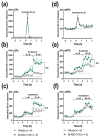Up and Down γ-Synuclein Transcription in Dopamine Neurons Translates into Changes in Dopamine Neurotransmission and Behavioral Performance in Mice
- PMID: 35163729
- PMCID: PMC8836558
- DOI: 10.3390/ijms23031807
Up and Down γ-Synuclein Transcription in Dopamine Neurons Translates into Changes in Dopamine Neurotransmission and Behavioral Performance in Mice
Abstract
The synuclein family consists of α-, β-, and γ-Synuclein (α-Syn, β-Syn, and γ-Syn) expressed in the neurons and concentrated in synaptic terminals. While α-Syn is at the center of interest due to its implication in the pathogenesis of Parkinson's disease (PD) and other synucleinopathies, limited information exists on the other members. The current study aimed at investigating the biological role of γ-Syn controlling the midbrain dopamine (DA) function. We generated two different mouse models with: (i) γ-Syn overexpression induced by an adeno-associated viral vector and (ii) γ-Syn knockdown induced by a ligand-conjugated antisense oligonucleotide, in order to modify the endogenous γ-Syn transcription levels in midbrain DA neurons. The progressive overexpression of γ-Syn decreased DA neurotransmission in the nigrostriatal and mesocortical pathways. In parallel, mice evoked motor deficits in the rotarod and impaired cognitive performance as assessed by novel object recognition, passive avoidance, and Morris water maze tests. Conversely, acute γ-Syn knockdown selectively in DA neurons facilitated forebrain DA neurotransmission. Importantly, modifications in γ-Syn expression did not induce the loss of DA neurons or changes in α-Syn expression. Collectively, our data strongly suggest that DA release/re-uptake processes in the nigrostriatal and mesocortical pathways are partially dependent on substantia nigra pars compacta /ventral tegmental area (SNc/VTA) γ-Syn transcription levels, and are linked to modulation of DA transporter function, similar to α-Syn.
Keywords: AAV vector; antisense oligonucleotide; cognitive dysfunction; dopamine; motor deficits; γ-synuclein.
Conflict of interest statement
A.B. is an inventor of the issued patents WO2011131693, WO-2014064257-A1, WO2014064258-A1 for ligand-conjugated siRNA and ASO molecules and the targeting approach for monoamine systems related to this work. The rest of the authors declare no competing interest.
Figures






Similar articles
-
Intracerebral Administration of a Ligand-ASO Conjugate Selectively Reduces α-Synuclein Accumulation in Monoamine Neurons of Double Mutant Human A30P*A53T*α-Synuclein Transgenic Mice.Int J Mol Sci. 2021 Mar 13;22(6):2939. doi: 10.3390/ijms22062939. Int J Mol Sci. 2021. PMID: 33805843 Free PMC article.
-
Selective α-Synuclein Knockdown in Monoamine Neurons by Intranasal Oligonucleotide Delivery: Potential Therapy for Parkinson's Disease.Mol Ther. 2018 Feb 7;26(2):550-567. doi: 10.1016/j.ymthe.2017.11.015. Epub 2017 Nov 29. Mol Ther. 2018. PMID: 29273501 Free PMC article.
-
Viral overexpression of human alpha-synuclein in mouse substantia nigra dopamine neurons results in hyperdopaminergia but no neurodegeneration.Exp Neurol. 2024 Dec;382:114959. doi: 10.1016/j.expneurol.2024.114959. Epub 2024 Sep 15. Exp Neurol. 2024. PMID: 39288832
-
Environment- and activity-dependent dopamine neurotransmitter plasticity in the adult substantia nigra.J Chem Neuroanat. 2016 Apr;73:21-32. doi: 10.1016/j.jchemneu.2015.12.009. Epub 2015 Dec 21. J Chem Neuroanat. 2016. PMID: 26718607 Review.
-
Reprint of: revisiting oxidative stress and mitochondrial dysfunction in the pathogenesis of Parkinson disease-resemblance to the effect of amphetamine drugs of abuse.Free Radic Biol Med. 2013 Sep;62:186-201. doi: 10.1016/j.freeradbiomed.2013.05.042. Epub 2013 Jun 3. Free Radic Biol Med. 2013. PMID: 23743292 Review.
Cited by
-
The Role of α-Synuclein in the Regulation of Serotonin System: Physiological and Pathological Features.Biomedicines. 2023 Feb 13;11(2):541. doi: 10.3390/biomedicines11020541. Biomedicines. 2023. PMID: 36831077 Free PMC article. Review.
-
Sex-Related Differences in Voluntary Alcohol Intake and mRNA Coding for Synucleins in the Brain of Adult Rats Prenatally Exposed to Alcohol.Biomedicines. 2022 Sep 2;10(9):2163. doi: 10.3390/biomedicines10092163. Biomedicines. 2022. PMID: 36140264 Free PMC article.
-
Loss of the Synuclein Family Members Differentially Affects Baseline- and Apomorphine-Associated EEG Determinants in Single-, Double- and Triple-Knockout Mice.Biomedicines. 2022 Dec 4;10(12):3128. doi: 10.3390/biomedicines10123128. Biomedicines. 2022. PMID: 36551884 Free PMC article.
-
Disruption of Electroencephalogram Coherence between Cortex/Striatum and Midbrain Dopaminergic Regions in the Knock-Out Mice with Combined Loss of Alpha, Beta, and Gamma Synucleins.Biomedicines. 2024 Apr 16;12(4):881. doi: 10.3390/biomedicines12040881. Biomedicines. 2024. PMID: 38672235 Free PMC article.
-
Synuclein Proteins in MPTP-Induced Death of Substantia Nigra Pars Compacta Dopaminergic Neurons.Biomedicines. 2022 Sep 14;10(9):2278. doi: 10.3390/biomedicines10092278. Biomedicines. 2022. PMID: 36140378 Free PMC article. Review.
References
-
- Abeliovich A., Schmitz Y., Fariñas I., Choi-Lundberg D., Ho W.H., Castillo P.E., Shinsky N., Verdugo J.M., Armanini M., Ryan A., et al. Mice lacking alpha-synuclein display functional deficits in the nigrostriatal dopamine system. Neuron. 2000;25:239–252. doi: 10.1016/S0896-6273(00)80886-7. - DOI - PubMed
MeSH terms
Substances
Grants and funding
LinkOut - more resources
Full Text Sources
Research Materials
Miscellaneous

